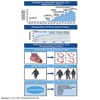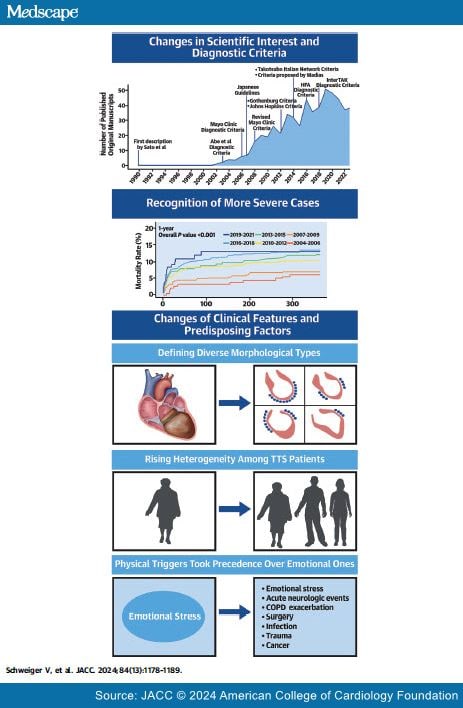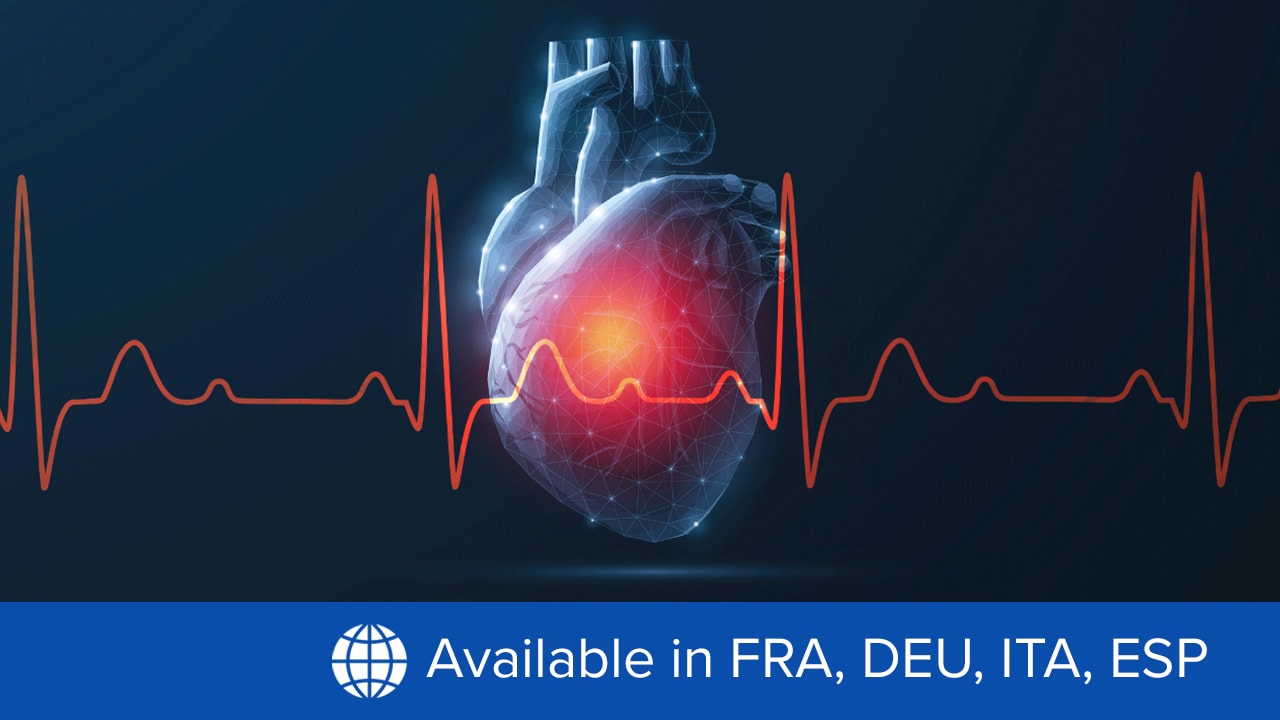Authors and Disclosures
Victor Schweiger, MD, PHD,a,b Victoria L. Cammann, MD, PHD,a Giulia Crisci, MD,c Thomas Gilhofer, MD,a Rabea Schlenker, MD,a David Niederseer, MD, PHD,d,e,f Shaojie Chen, MD,g Ramin Ebrahimi, MD,g,h Florian Wenzl, MD,i Michael Würdinger, MD,a Rodolfo Citro, MD, PHD,j,k Carmine Vecchione, MD,j,l Sebastiano Gili, MD,m Michael Neuhaus, MD,n Jennifer Franke, MD,o Benjamin Meder, MD,o Miłosz Jaguszewski, MD, PHD,p Michel Noutsias, MD,q Maike Knorr, MD,r Thomas Jansen, MD,r Fabrizio D’Ascenzo, MD, PHD,s Wolfgang Dichtl, MD, PHD,t Dirk von Lewinski, MD,u Christof Burgdorf, MD,v Behrouz Kherad, MD,b Carsten Tschöpe, MD,b Annahita Sarcon, MD,w Jerold Shinbane, MD,x Lawrence Rajan, MD,y Guido Michels, MD,z Roman Pfister, MD,b Alessandro Cuneo, MD,aa Claudius Jacobshagen, MD,bb,cc Mahir Karakas, MD,dd,ee Wolfgang Koenig, MD,ff,gg Alexander Pott, MD,hh Philippe Meyer, MD,ii Marco Roffi, MD,ii Adrian Banning, MD,jj Mathias Wolfrum, MD,kk Florim Cuculi, MD,kk Richard Kobza, MD,kk Thomas A. Fischer, MD,ll Tuija Vasankari,mm K.E. Juhani Airaksinen, MD, PHD,mm L. Christian Napp, MD,nn Rafal Dworakowski, MD,oo Philip MacCarthy, MD, PHD,oo Christoph Kaiser, MD,pp Stefan Osswald, MD,pp Leonarda Galiuto, MD, PHD,qq Christina Chan, MD,rr Paul Bridgman, MD,rr Daniel Beug, MD,ss,tt Clément Delmas, MD,uu Olivier Lairez, MD, PHD,uu Ekaterina Gilyarova, MD,vv Alexandra Shilova, MD, PHD,vv Mikhail Gilyarov, MD, PHD,vv Ibrahim El-Battrawy, MD,ww,xx Ibrahim Akin, MD,ww,xx Karolina Poledniková, MD,yy Petr Tousek, MD, PHD,yy David E. Winchester, MD,zz Michael Massoomi, MD,zz Jan Galuszka, MD, PHD,aaa Christian Ukena, MD,bbb Gregor Poglajen, MD, PHD,ccc Pedro Carrilho-Ferreira, MD,ddd Christian Hauck, MD,eee Carla Paolini, MD,fff Claudio Bilato, MD, PHD,fff Yoshio Kobayashi, MD, PHD,ggg Ken Kato, MD, PHD,ggg Iwao Ishibashi, MD, PHD,hhh Toshiharu Himi, MD, PHD,iii Jehangir Din, MD,jjj Ali Al-Shammari, MD,jjj Abhiram Prasad, MD,kkk Charanjit S. Rihal, MD,kkk Kan Liu, MD, PHD,lll P. Christian Schulze, MD,mmm Matteo Bianco, MD,nnn Lucas Jörg, MD,ooo Hans Rickli, MD,ooo Gonçalo Pestana, MD,ppp Thanh H. Nguyen, MD, PHD,qqq Michael Böhm, MD,bbb Lars S. Maier, MD,eee Fausto J. Pinto, MD, PHD,ddd Petr Widimský, MD, PHD,yy Stephan B. Felix, MD,ss,tt Ruediger C. Braun-Dullaeus, MD,rrr Wolfgang Rottbauer, MD,hh Gerd Hasenfuß, MD,bb Burkert M. Pieske, MD,sss,ttt Heribert Schunkert, MD,ff,gg Monika Budnik, MD, PHD,uuu Grzegorz Opolski, MD, PHD,uuu Holger Thiele, MD,vvv Johann Bauersachs, MD,nn John D. Horowitz, MBBS, PHD,qqq Carlo Di Mario, MD, PHD,www William Kong, MD,xxx Mayank Dalakoti, MD,xxx Yoichi Imori, MD, PHD,yyy Thomas Münzel, MD,r Luca Liberale, MD, PHD,qq Fabrizio Montecucco, MD, PHD,zzz,aaaa Jeroen J. Bax, MD, PHD,bbbb Filippo Crea, MD,qq Frank Ruschitzka, MD,a Thomas F. Lüscher, MD,i,cccc Jelena R. Ghadri, MD,a Eduardo Bossone, MD, PHD,dddd Christian Templin, MD, PHD,i,ss,tt,eeee Davide Di Vece, MDss,tt,zzz
From the aUniversity Heart Center, Department of Cardiology, University Hospital Zurich, and University of Zurich, Zurich, Switzerland; bDepartment of Cardiology, Deutsches Herzzentrum der Charité, Angiology and Intensive Care Medicine, Berlin, Germany; cDepartment of Translational Medical Sciences, “Federico II” University, Naples, Italy; dHochgebirgsklinik, Medicine Campus Davos, Davos, Switzerland; eChristine Kühne Center for Allergy Research and Education (CK-CARE), Medicine Campus Davos, Davos, Switzerland; fCenter of Translational and Experimental Cardiology, University Hospital Zurich, Zurich Switzerland; gCardioangiologisches Centrum Bethanien (CCB), Kardiologie, Medizinische Klinik III, Agaplesion Markus Krankenhaus, Akademisches Lehrkrankenhaus der Goethe-Universität Frankfurt am Main, Frankfurt am Main, Germany; hHeart Clinic Pratteln, Zentrum für Kardiologie, Pratteln, Switzerland; iCenter for Molecular Cardiology, Schlieren Campus, University of Zurich, Zurich, Switzerland; jDepartment of Vascular Physiopathology, IRCCS Neuromed, Pozzilli, Italy; kDivision of Clinical Cardiology Research Responsible Hospital, Department of Medicine and Health Science, University of Molise, Campobasso, Italy; lDepartment of Medicine, Surgery and Dentistry, University of Salerno, Baronissi, Salerno, Italy; mCentro cardiologico Monzino, IRCCS, Milan, Italy; nDepartment of Cardiology, Kantonsspital Frauenfeld, Frauenfeld, Switzerland; oDepartment of Cardiology, Heidelberg University Hospital, Heidelberg, Germany; pFirst Department of Cardiology, Medical University of Gdansk, Gdansk, Poland; qMid-German Heart Center, Department of Internal Medicine III, Division of Cardiology, Angiology and Intensive Medical Care, University Hospital Halle, Martin-Luther-University Halle-Wittenberg, Halle (Saale), Germany; rCenter for Cardiology, Cardiology 1, University Medical Center Mainz, Mainz, Germany; sDivision of Cardiology, Department of Medical Sciences, AOU Città della Salute e della Scienza, University of Turin, Turin, Italy; tUniversity Hospital for Internal Medicine III (Cardiology and Angiology), Medical University Innsbruck, Innsbruck, Austria; uDivision of Cardiology, Medical University of Graz, Graz, Austria; vHeart and Vascular Centre Bad Bevensen, Bad Bevensen, Germany; wSection of Cardiac Electrophysiology, Department of Medicine, University of California-San Francisco, San Francisco, California, USA; xUniversity of Southern California, Keck School of Medicine, Los Angeles, California, USA; yTJ Health Partners Heart and Vascular, Glasgow, Kentucky, USA; zKlinik für Akut-und Notfallmedizin, St Antonius Hospital gGmbH, Akademisches Lehrkrankenhaus der RWTH Aachen, Eschweiler, Germany; aaKrankenhaus “Maria Hilf” Medizinische Klinik, Stadtlohn, Germany; bbClinic for Cardiology and Pneumology, Georg August University Goettingen, Goettingen, Germany; ccVincentius-Diakonissen Hospital, Karlsruhe, Germany; ddDepartment of Intensive Care Medicine, University Medical Center Hamburg-Eppendorf, Hamburg, Germany; eeDZHK (German Centre for Cardiovascular Research), partner site Hamburg/Kiel/Luebeck, Hamburg, Germany; ffDeutsches Herzzentrum München, Technische Universität München, Munich, Germany; ggDZHK (German Centre for Cardiovascular Research), partner site Munich Heart Alliance, Munich, Germany; hhDepartment of Internal Medicine II–Cardiology, University of Ulm, Medical Center, Ulm, Germany; iiService de cardiologie, Hôpitaux Universitaires de Genève, Geneva, Switzerland; jjDepartment of Cardiology, John Radcliffe Hospital, Oxford University Hospitals, Oxford, United Kingdom; kkDepartment of Cardiology, Kantonsspital Lucerne, Lucerne, Switzerland; llDepartment of Cardiology, Kantonsspital Winterthur, Winterthur, Switzerland; mmHeart Center, Turku University Hospital and University of Turku, Turku, Finland; nnDepartment of Cardiology and Angiology, Hannover Medical School, Hannover, Germany; ooDepartment of Cardiology, King’s College Hospital, London, United Kingdom; ppDepartment of Cardiology, University Hospital Basel, Basel, Switzerland; qqFondazione Policlinico Universitario A. Gemelli IRCCS, Università Cattolica Del Sacro Cuore, Rome, Italy; rrDepartment of Cardiology, Christchurch Hospital, Christchurch, New Zealand; ssDepartment of Cardiology and Internal Medicine B, University Medicine Greifswald, Greifswald, Germany; ttDZHK (German Centre for Cardiovascular Research), partner site Greifswald, Greifswald, Germany; uuDepartment of Cardiology and Cardiac Imaging Center, University Hospital of Rangueil, Toulouse, France; vvIntensive coronary care Unit, Moscow City Hospital #1 named after N. Pirogov, Moscow, Russia; wwFirst Department of Medicine, Faculty of Medicine, University Medical Centre Mannheim (UMM) University of Heidelberg, Mannheim, Germany; xxDZHK (German Center for Cardiovascular Research), partner site, Heidelberg-Mannheim, Mannheim, Germany; yyCardiocenter, Third Faculty of Medicine, Charles University in Prague and University Hospital Královské Vinohrady, Prague, Czech Republic; zzDivision of Cardiovascular Medicine, Department of Medicine, College of Medicine, University of Florida, Gainesville, Florida, USA; aaaDepartment of Internal Medicine I-Cardiology, University Hospital Olomouc, Olomouc, Czech Republic; bbbKlinik für Innere Medizin III, Universitätsklinikum des Saarlandes, Homburg/Saar, Germany; cccAdvanced Heart Failure and Transplantation Center, University Medical Center Ljubljana, Ljubljana, Slovenia; dddSanta Maria University Hospital, CHULN, Center of Cardiology of the University of Lisbon, Lisbon School of Medicine, Lisbon Academic Medical Center, Lisboa, Portugal; eeeKlinik und Poliklinik für Innere Medizin II, Universitätsklinikum Regensburg, Regensburg, Germany; fffLocal Health Unit no.8, Cardiology Unit, Arzignano, Vicenza, Italy; gggDepartment of Cardiovascular Medicine, Chiba University Graduate School of Medicine, Chiba, Japan; hhhDepartment of Cardiology, Chiba Emergency Medical Center, Chiba, Japan; iiiDivision of Cardiology, Kimitsu Central Hospital, Kisarazu, Japan; jjjDorset Heart Centre, Royal Bournemouth Hospital, Bournemouth, United Kingdom; kkkDepartment of Cardiovascular Diseases, Mayo Clinic, Rochester, Minnesota, USA; lllDivision of Cardiology, Heart and Vascular Center, University of Iowa, Iowa City, Iowa, USA; mmmDepartment of Internal Medicine I, University Hospital Jena, Friedrich- Schiller-University Jena, Jena, Germany; nnnDivision of Cardiology, A.O.U San Luigi Gonzaga, Orbassano, Turin, Italy; oooDepartment of Cardiology, Kantonsspital St Gallen, St Gallen, Switzerland; pppDepartment of Cardiology, Centro Hospitalar Universitário de São João, E.P.E., Porto, Portugal; qqqDepartment of Cardiology, Basil Hetzel Institute, Queen Elizabeth Hospital, University of Adelaide, Adelaide, South Australia, Australia; rrrDepartment of Internal Medicine, Cardiology and Angiology, Magdeburg University, Magdeburg, Germany; sssDeutsches Herzzentrum der Charité, Department of Cardiology (CVK) and German Centre for Cardiovascular Research (DZHK)-Partner Site Berlin, Charité Universitätsmedizin Berlin, Berlin, Germany; tttBerlin Institute of Health (BIH) at Charité–Center for Regenerative Therapies, Universitätsmedizin Berlin, Berlin, Germany; uuuDepartment of Cardiology, Medical University of Warsaw, Warsaw, Poland; vvvHeart Center Leipzig–At Leipzig University, Department of Internal Medicine/Cardiology, Leipzig Heart Science, Leipzig, Germany; wwwStructural Interventional Cardiology, Careggi University Hospital, Florence, Italy; xxxDepartment of Cardiology, National University Heart Centre, Singapore; yyyDepartment of Cardiovascular Medicine, Nippon Medical School, Tokyo, Japan; zzzFirst Clinic of Internal Medicine, Department of Internal Medicine, University of Genoa, Genoa, Italy; aaaaIRCCS Ospedale Policlinico San Martino, Genoa-Italian Cardiovascular Network, Genoa, Italy; bbbbDepartment of Cardiology, Leiden University Medical Centre, Leiden, the Netherlands; ccccRoyal Brompton and Harefield Hospitals Trust and Imperial College, London, United Kingdom; ddddDepartment of Public Health, University "Federico II" of Naples, Naples, Italy; and the eeeeSwiss CardioVascularClinic, Private Hospital Bethanien, Zurich, Switzerland.
The authors attest they are in compliance with human studies committees and animal welfare regulations of the authors’ institutions and Food and Drug Administration guidelines, including patient consent where appropriate.
FUNDING SUPPORT AND AUTHOR DISCLOSURES: Dr Templin has received institutional grants from Abbott Vascular, Medtronic, and SMT; and has received consulting grants from Biotronik, Microport, and Innova. Dr Airaksinen has received grants or has contracts with the Finnish Foundation for Cardiovascular Research; and has received payment or honoraria for lectures, presentations, speakers bureaus, manuscript writing, or educational events from Bayer, Pfizer, Boehringer Ingelheim, and AstraZeneca. Dr Bauersachs has received grants from or has contracts with Abiomed, CVRx, Norgine, Roche, and Zoll; holds patents PCT/EP2007/ 008772 and PCT/EP2009/051986 for microRNA and downstream targets for diagnostics and therapeutic purposes; has received consulting fees from Amgen, AstraZeneca, Bayer, Bristol Myers Squibb, Boehringer Ingelheim, Cardior, Corvia, CVRx, Edwards, Norgine, Novartis, Pfizer, Roche, and Vifor; and has received payment or honoraria for lectures, presentations, speakers bureaus, manuscript writing, or educational events from Amgen, AstraZeneca, Bayer, Bristol Myers Squibb, Boehringer Ingelheim, Cardior, CVRx, Norgine, Novartis, Pfizer, and Vifor. Dr Boehm has received grants from or has contracts with Deutsche Forschungsgemeinschaft research support (DFG, SFB-TTR 219, S-01); has received speaker honoraria from Abbott, Amgen, AstraZeneca, Bayer, Boehringer Ingelheim, Bristol Myers Squibb, Cytokinetics, Medtronic, Novartis, Servier, and Vifor; and is on the advisory board of Amgen, Bayer, Boehringer Ingelheim, Cytokinetics, Medtronic, Novartis, Pfizer, ReCor, Servier, and Vifor. Dr Ferreira has received payments for lectures, presentations, speakers bureaus, manuscript writing, or educational events from A Menarini, Medinfar, Bayer, AstraZeneca, Biotronik, and Medtronic; and has received payments for participation on a Data Safety MoniMonitoring Board or Advisory Board from Medtronic. Dr Dichtl has received consulting fees from Reata. Dr Kaiser has received consulting fees from the Swiss Federal Office of Public Health; and has received support for attending meetings and/or travel from Medtronic, Abbott, and Europa Organization. Dr Kobza has received institutional grants on behalf of the Luzerner Kantonsspital from Biosense Webster, Boston Scientific, Biotronik, Medtronik, and Sis- Medical; and has received consulting fees from Biosense Webster, Biotronik, and Medtronic. Dr Koenig has received grants and provision of reagents to the institution from Singulex, Dr.Beckmann Pharma, Abbott, and Roche Diagnostics; has received consulting fees from AstraZeneca, Novartis, Amgen, Pfizer, The Medicines Company, DalCor Pharmaceuticals, Kowa, Corvidia Therapeutics, OMEICOS, Daiichi-Sankyo, Novo Nordisk, New Amsterdam Pharma, TenSixteen Bio, Esperion, and Genentech; and has received lecture fees from Bristol Myers Squibb, Novartis, Amgen, Berlin-Chemie, Sanofi, and AstraZeneca. Dr Lüscher has received research or educational grants to the institution from Abbott, Amgen, AstraZeneca, Boehringer Ingelheim, Daiichi-Sankyo, Novartis, Novo Nordisk, Sanofi, and Vifor; is the president elect of the European Society of Cardiology; is chairman of the research committee of the Swiss Heart Foundation; is President of the Board of the Zurich Heart House; and is Trustee of the London Heart House. Dr Karakas has received grants or has contracts with Vifor Pharma and Daiichi-Sankyo; has received consulting fees or payment or honoraria for lectures, presentations, speakers bureaus, manuscript writing, or educational events from Vifor, Pharmacosmos, and Sphingotec; and has received equipment, materials, drugs, medical writing, gifts or other services from Sphingotec and Vifor Pharma. Dr Niederseer has received consulting fees from Amgen, AstraZeneca, Bayer, Boehringer Ingelheim, Daiichi-Sankyo, Gerson Lehmann Group (GLG) Consulting, Novo Nordisk, Pfizer and Zoll; has received payment or honoraria for lectures, presentations, speakers bureaus, manuscript writing, or educational events from Amgen, AstraZeneca, Bayer, Boehringer Ingelheim, Daiichi-Sankyo, Novartis, Novo Nordisk, and Pfizer; and has received support for attending meetings and/or travel from Abbott, Amgen, Bayer, and Novo Nordisk. Dr Roffi has received institutional research grants from Boston Scientific, Cordis, Terumo, Biotronik, and Medtronic. Dr Ruschitzka has not received personal payments by pharmaceutical companies or device manufacturers in the last 3 years; the Department of Cardiology (University Hospital of Zurich/University of Zurich), however, reports research, educational, and/or travel grants from Abbott, Abiomed, Alexion, Amgen, AstraZeneca, At the Limits Ltd, Bayer, Berlin Heart, B. Braun, Biosense Webster, Biosensors Europe AG, Biotronik, Bristol Myers Squibb, Boehringer Ingelheim, Boston Scientific, Bracco, Cardinal Health Switzerland, Concept Medical, Corteria, CSL, Daiichi-Sankyo, Diatools AG, Edwards Lifesciences, Guidant Europe NV, Hamilton Health Sciences, IHF, Innosuisse, Johnson/Johnson, Kaneka Corporation, Kantar, Kiniksa, Labormedizinisches Zentrum, MedAlliance, Medical Education Global Solutions, Medtronic, MicroPort, MSD, Mundipharma Medical Company, Novartis, Novo Nordisk, Orion, Pfizer, Quintiles Switzerland Sarl, RecorMedical, Roche Diagnostics, Roche Pharma, Sahajanand IN, Sanofi, Sarstedt AG, Servier, SIS Medical, Sorin CRM SAS, SSS International Clinical Research, Stromal, Terumo Deutschland, Trama Solutions, V-Wave, Vascular Medical, Vifor, Wissens Plus, and ZOLL. Prof Ruschitzka has not received personal payments by pharmaceutical companies or device manufacturers in the last 3 years; remuneration for the time spent in the following consulting activities were made directly to the University of Zurich and do not impact on his personal remuneration: AstraZeneca (IMC), Bayer, Boehringer Ingelheim, Citi Research, Klub Class, Novo Nordisk, Radcliffe Group, Stiftung Pfizer Forschungspreis, and Vifor; remuneration for the following lectures were made directly to the University of Zurich and do not impact on his personal remuneration: Abbott, Amgen, Astra- Zeneca (Aþ Science AB), Bayer (At the Limits), Boehringer Ingelheim, Boston Scientific (CCE Services), Brigham and Women’s Hospital Boston, C.T.I GmbH, FomF, Hôpitaux Universitaires des Genève (GECORE), Luzerner Kantonsspital, Sanofi-Aventis, Servier, Medcon, Medscape (WebMD), Medtronic, Medworld, Novartis, Roche, Ruwag, Swiss Heart Failure Academy, The Hong Kong Heart Failure Society, Trama Solutions SL, Inselspital Bern, Charité–Universitätsmedizin Berlin (Medical Education Global Solutions), Romanian Society of Cardiology, ÖKG Österreichische Gesellschaft für Kardiologie, and Zoll; has received support for attending meetings and/or travel from AstraZeneca (IMC/Aþ Science AB), Boehringer Ingelheim, Centro Hospitaler de Vila Nova de Gaia, C.T.I. GmbH (Universitätsklinikum Düsseldorf), European Society of Cardiology, Monocle, Novartis, Spektar Putovanja, Austrian Heart Failure Association, and Heart Failure Association of the ESC; remuneration for following Advisory Boards were made directly to the University of Zurich and do not impact on his personal remuneration: Bayer, Roche, IMC/ AstraZeneca, and Amgen; and he has received secretarial and administrative support of the HFA for his role as President/Past- President for 2018 to 2020. Dr Schunkert has received consulting fees from Amgen, Daiichi-Sankyo, Merck Sharp and Dohme, Astra- Zeneca, Bayer, Boehringer Ingelheim, Novartis, and Servier; has received honoraria for lectures, presentations, speakers bureaus, manuscript writing, or educational events and support for attending meetings and/or travel from Amgen, AstraZeneca, Bayer, Boehringer Ingelheim, Bristol Myers Squibb, Daiichi-Sankyo, Merck Sharp and Dohme, Novartis, Sanofi Aventis, Servier, and Synlab; and has received honoraria for his participation on a Data Safety Monitoring Board or Advisory Board of Boehringer Ingelheim, Daiichi-Sankyo, Novartis, and Amgen. Dr Wolfrum has received consulting fees from NVT/Biosensors as well as payments for lectures, presentations, speakers bureaus, manuscript writing, or educational events from NVT/Biosensors; and has equities in Hi-D Imaging, Winterthur, Switzerland. Dr Crea has received personal fees from Amgen, Astra- Zeneca, Abbott, Menarini, Chiesi, and Daiichi-Sankyo, outside of the submitted work. All other authors have reported that they have no relationships relevant to the contents of this paper to disclose.
ADDRESS FOR CORRESPONDENCE: Dr Christian Templin, Department of Cardiology, University Heart Center, University Hospital Zurich, Rämistrasse 100, 8091 Zurich, Switzerland. E-mail: christian.templin@ usz.ch.







